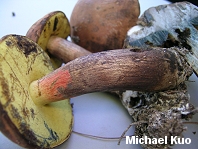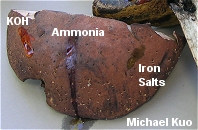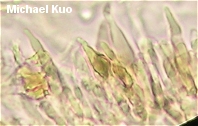| Major Groups > Boletes > Boletus > Boletus oliveisporus |

|
Boletus oliveisporus [ Basidiomycetes > Boletales > Boletaceae > Boletus . . . ] by Michael Kuo This southern bolete is an eager blue-stainer, found under longleaf pine and loblolly pine. Its stem is its most distinctive feature: when young the apex is yellow and the base is brown, with a bright pinkish red zone in between. With maturity the brown shades move upwards, conquering the red zone. It is not reticulate, but on close inspection the stem surface appears "punctate" with tiny dots. Boletus pulverulentus is similar (and southern records of this species may represent confusion with Boletus oliveisporus), but its cap surface turns green with ammonia.
Description: Ecology: Mycorrhizal with longleaf pine and loblolly pine; growing alone, scattered, or gregariously; reported by Singer (1947) to sometimes appear on stumps; summer and fall; along the Gulf Coast and the southeastern Atlantic Coast. Cap: 6-18 cm; convex, becoming broadly convex or almost flat; dry; dull; smooth or finely velvety; reddish brown to brown; bruising blue to black on handling; with a slightly overhanging sterile margin. Pore Surface: Yellow, becoming olive yellow; bruising promptly blue, then slowly brown; 1-2 pores per mm at maturity; tubes to 2 cm deep. Stem: 4-8.5 cm long; 1-5 cm thick; more or less equal; solid; yellow at the apex and brown at the base, often with a pinkish red zone in between; appearing finely punctate; becoming brown overall from the base up; not reticulate. Flesh: Whitish to yellow; bluing on exposure. Odor and Taste: Not distinctive. Chemical Reactions: Ammonia negative to slowly red or blackish on cap surface; erasing blued areas of flesh to yellowish or orangish. KOH orange to negative or brownish on cap surface; yellowish to orangish on flesh. Iron salts gray on cap surface; greenish on flesh. Spore Print: Olive brown. Microscopic Features: Spores 11-17 x 4-6 µ; smooth; subfusiform; yellowish in KOH. Hymenial cystidia fusoid to fusoid-ventricose; yellowish in KOH, often with refractive contents; to about REFERENCES: (Murrill) Murrill, 1945. (Singer, 1947; Metzler & Metzler, 1992; Both, 1993; Bessette, Roody & Bessette, 2000.) Herb. Kuo 10200705. This site contains no information about the edibility or toxicity of mushrooms. |
© MushroomExpert.Com |
|
Cite this page as: Kuo, M. (2007, December). Boletus oliveisporus. Retrieved from the MushroomExpert.Com Web site: http://www.mushroomexpert.com/boletus_oliveisporus.html |


